Leak Management in Water Distribution Networks Through Deep Reinforcement Learning: A Review
Abstract
1. Introduction
2. Methodology
Paper Identification and Screening
3. Leakage Management in Water Distribution Networks
3.1. Leakage Assessment Methods
3.2. Leakage Detection Methods
3.2.1. Hardware-Based Leakage Detection Methods
3.2.2. Software-Based Leakage Detection Methods
3.3. Leakage Prevention (Control)
3.4. Evaluation Criteria and Performance of Leak Management Methods
4. Deep Reinforcement Learning Background
4.1. Reinforcement Learning
4.2. Deep Reinforcement Learning (DRL)
4.3. RL and DRL Algorithms
- Value-based DRL algorithms: These methods learn action values in different states and derive a policy from these values. Examples include Deep Q-Networks (DQNs) and its variants like Double DQN, Duelling DQN, and Rainbow DQN. Value-based methods excel at discrete action spaces but may struggle with continuous action spaces [16,18,52,121].
- Policy-based DRL algorithms: These approaches directly learn policy-mapping states to actions without an intermediate-value function. Methods such as REINFORCE, Trust Region Policy Optimisation (TRPO), and Proximal Policy Optimisation (PPO) fall into this category. Policy-based methods naturally handle continuous action spaces and typically have better convergence properties but may suffer from high variance [114].
- Actor–critic DRL algorithms: These hybrid methods combine value-based and policy-based approaches by maintaining both a policy (actor) and a value function (critic). The actor selects actions, whereas the critic evaluates these actions by estimating the value function. Examples include Advantage Actor–Critic (A2C), Deep Deterministic Policy Gradient (DDPG), and Soft Actor–Critic (SAC). This synergy enables more effective learning, as the policy adjusts based on feedback from the value function [16,51,114,122].
4.4. Applications of DRL in Water Sector
4.4.1. DRL in Stormwater
4.4.2. DRL in Water Distribution Networks
4.4.3. DRL in Water Quality Applications
4.5. Challenges of DRL in WDNs
- Data Availability and Quality: One major challenge is the availability and quality of data. Incomplete or inaccurate data can significantly affect the performance of DRL algorithms. High-quality labelled data are crucial for training DRL models; however, acquiring these data is difficult because of sparse and noisy measurements that are influenced by inaccuracies and environmental factors. The lack of historical data further complicates the model training, making it more difficult to create robust models [16,24,99]. This scarcity can hinder the training and accuracy of DRL models.
- Simulation-to-Real Gap: Most RL research on water systems has been confined to simulation-based environments. Although simulations offer safety and control platforms for model development, they often fail to capture the full complexity and unpredictability of real-world systems. Consequently, a significant simulation-to-reality gap exists, which impedes the operational deployment of RL agents. Bridging this gap will require robust techniques for policy generalisation, domain adaptation, and transfer learning to ensure that RL models can function reliably in practical water distribution scenarios [116].
- Scalability in Large Networks: Scalability is also a significant concern for DRL applications. Conventional DRL algorithms may experience a decline in performance as the network size increases, with the number of possible states and actions growing exponentially. This makes it challenging for DRL algorithms to effectively manage larger WDNs. To address this issue, there is a demand for algorithms that can handle more intricate environments, such as hierarchical DRL algorithms, which enable learning in multiple abstractions [53].
- Computational Complexity: The computational complexity involved in training DRL agents is another challenge, particularly in complex systems such as WDNs. Training involves exploring several possible states and actions that require substantial computational resources. Without sufficient computational power, the training may be limited, thereby affecting the generalisation capabilities of the model [16,26,124,138].
- Sensitivity to Network Architecture: Sensitivity to the neural network architecture also presents a significant challenge in achieving optimal control performance. Architecture, including layers, neurones, and hyperparameters, plays a crucial role in effective learning. However, determining the best structure often requires trial and error, which is time-consuming and lacks systematic methods [16,124].
- Reward Function Design: Another challenge is the manual and often heuristic-based approach to reward function design, which involves significant trial and error and domain expertise. This not only prolongs the development cycle but also risks suboptimal learning outcomes. Future efforts should explore automated reward shaping using techniques such as inverse RL, meta-learning, or preference elicitation from domain experts to enable more structured and adaptive reward engineering [116].
- Credit Assignment Problem: In dynamic environments, such as WDNs, rewards often occur long after a causative action, making it difficult to attribute outcomes accurately. This temporal credit assignment problem complicates learning and necessitates architectures capable of managing long-term dependencies [16,115].
- Exploration vs. Exploitation Trade-off: The exploration versus exploitation dilemma is a significant challenge for most RL and DRL algorithms, as agents often act in a manner that prioritises immediate rewards. Because an agent’s observations are influenced by its actions and its actions are driven by the rewards it receives, RL agents can become trapped in a cycle around a local optimum instead of discovering the global optimum through exploitation. To address this issue, introducing randomness into the agent’s behaviour is essential, as it allows the agent to gather new observations and potentially explore global optima [16].
- Leak-specific Challenges: Leakage events, particularly background leaks, present a unique challenge in DRL-based water network management because of their sparse, prolonged, and often undetectable nature. Unlike burst leaks, which have more identifiable hydraulic signatures, background leaks often persist silently and offer little or no immediate feedback from which DRL agents can learn. This creates a sparse reward environment that complicates agent training and may cause overfitting in normal (non-leak) scenarios. Additionally, DRL-based prevention strategies, such as pressure management, must overcome the complexity of minimising leakage while maintaining regulatory pressure thresholds without the benefit of clear detection signals. Therefore, developing effective DRL policies for leak-specific tasks requires careful reward shaping, environmental design, and policy generalisation [16,18,99].
5. Future Directions
- Domain-specific DRL Environment Development: There need to develop benchmarked, open-source DRL environments tailored to leakage detection and prevention tasks in WDNs. These should integrate realistic hydraulic models (e.g., EPANET and WNTR) and simulate various leak scenarios, sensor configurations, and operational constraints.
- Improved State Representation and Reward Design: Effective use of DRL depends on how well the environmental states and objectives are defined. Future work should explore encoding spatial–temporal patterns of pressure, flow, and demand into state vectors that reflect real-time network conditions. Similarly, multi-objective reward functions should be designed to capture the trade-offs between leak detection accuracy, computational efficiency, and operational feasibility. Incorporating domain knowledge, such as hydraulic principles, can further constrain learning toward physically meaningful and efficient solutions [18,129].
- Transferability Across Networks: Most DRL models are network-specific and require retraining when applied to new systems. To increase generalisability, researchers should develop methods that support transfer learning across different network topologies, demand patterns, and boundary conditions. This can involve domain adaptation, hybrid synthetic–real datasets, or curriculum learning strategies. Such approaches would reduce the dependence on labelled data and allow faster adaptation of models across utilities.
- Integration with Real-Time Systems: Bridging simulation-based DRL with real-time leak management systems remains a key challenge. Studies should explore hybrid DRL + heuristic control, online learning, or human-in-the-loop frameworks.
- Multi-Agent and Multi-Objective DRL: Given the distributed nature of WDNs, multi-agent reinforcement learning (MARL) can be explored to allow decentralised decision-making. Similarly, multi-objective formulations can balance leak detection with pressure control and energy savings [16].
- Explainability and Trustworthiness: Future models should include interpretability features to support decision makers, particularly in safety-critical scenarios involving large-scale leak events or system failures [16].
- Pilot Studies: Real-world pilot studies are essential for validating simulation-trained agents under field conditions. These studies should include rigorous monitoring protocols and allow researchers to assess both technical performance and operational viability. Hybrid model- and data-driven systems are particularly promising in this context, offering sensor-free yet hydraulically realistic environments for training and evaluation [16].
6. Conclusions
Author Contributions
Funding
Data Availability Statement
Acknowledgments
Conflicts of Interest
References
- UNICEF. Water Scarcity. Available online: https://www.unicef.org/wash/water-scarcity (accessed on 17 April 2025).
- UNESCO. Imminent Risk of a Global Water Crisis, Warns the UN World Water Development Report 2023. Available online: https://www.unesco.org/en/articles/imminent-risk-global-water-crisis-warns-un-world-water-development-report-2023 (accessed on 17 April 2025).
- UN-Water. Water and Urbanization. Available online: https://www.unwater.org/water-facts/water-and-urbanization (accessed on 17 April 2025).
- Ali, A.; Abdelmoez, M.; Heshmat, M.; Ibrahim, K. A Solution for Water Management and Leakage Detection Problems Using IoTs Based Approach. Internet Things 2022, 18, 100504. [Google Scholar] [CrossRef]
- Chris, B. Tracking down Three Billion Litres of Lost Water. BBC News. 18 August 2020. Available online: https://www.bbc.co.uk/news/business-53274914 (accessed on 17 April 2025).
- Farah, E.; Shahrour, I. Water Leak Detection: A Comprehensive Review of Methods, Challenges, and Future Directions. Water 2024, 16, 2975. [Google Scholar] [CrossRef]
- Hirner, W.; Lambert, A. Losses from Water Supply Systems: Standard Terminology and Recommended Performance Measures; International Water Association (IWA): London, UK, 2000. [Google Scholar]
- AL-Washali, T.; Sharma, S.; Kennedy, M. Methods of Assessment of Water Losses in Water Supply Systems: A Review. Water Resour. Manag. 2016, 30, 4985–5001. [Google Scholar] [CrossRef]
- Joseph, K.; Sharma, A.K.; van Staden, R. Development of an Intelligent Urban Water Network System. Water 2022, 14, 1320. [Google Scholar] [CrossRef]
- Negm, A.; Ma, X.; Aggidis, G. Review of Leakage Detection in Water Distribution Networks. IOP Conf. Ser. Earth Environ. Sci. 2023, 1136, 012052. [Google Scholar] [CrossRef]
- Gupta, A.; Kulat, K.D. A Selective Literature Review on Leak Management Techniques for Water Distribution System. Water Resour. Manag. 2018, 32, 3247–3269. [Google Scholar] [CrossRef]
- Serafeim, A.V.; Fourniotis, N.T.; Deidda, R.; Kokosalakis, G.; Langousis, A. Leakages in Water Distribution Networks: Estimation Methods, Influential Factors, and Mitigation Strategies—A Comprehensive Review. Water 2024, 16, 1534. [Google Scholar] [CrossRef]
- Gao, J.; Li, K.; Wu, W.; Chen, J.; Zhang, T.; Deng, L.; Xin, P. Innovative Water Supply Network Pressure Management Method—The Establishment and Application of the Intelligent Pressure-Regulating Vehicle. Energies 2022, 15, 1870. [Google Scholar] [CrossRef]
- Zaman, D.; Tiwari, M.K.; Gupta, A.K.; Sen, D. A Review of Leakage Detection Strategies for Pressurised Pipeline in Steady-State. Eng. Fail. Anal. 2020, 109, 104264. [Google Scholar] [CrossRef]
- Yussof, N.A.M.; Ho, H.W. Review of Water Leak Detection Methods in Smart Building Applications. Buildings 2022, 12, 1535. [Google Scholar] [CrossRef]
- Negm, A.; Ma, X.; Aggidis, G. Deep Reinforcement Learning Challenges and Opportunities for Urban Water Systems. Water Res. 2024, 253, 121145. [Google Scholar] [CrossRef] [PubMed]
- Michael, G.; Shahra, E.Q.; Basurra, S.; Wu, W.; Jabbar, W.A. Real-Time Pipeline Fault Detection in Water Distribution Networks Using You Only Look Once V8. Sensors 2024, 24, 6982. [Google Scholar] [CrossRef]
- Belfadil, A.; Modesto, D.; Meseguer, J.; Joseph-Duran, B.; Saporta, D.; Hernandez, J.A.M. Leveraging Deep Reinforcement Learning for Water Distribution Systems with Large Action Spaces and Uncertainties: DRL-EPANET for Pressure Control. J. Water Resour. Plan. Manag. 2023, 150, 04023076. [Google Scholar] [CrossRef]
- Parvaze, S.; Kumar, R.; Khan, J.N.; Al-Ansari, N.; Parvaze, S.; Vishwakarma, D.K.; Elbeltagi, A.; Kuriqi, A. Optimisation of Water Distribution Systems Using Genetic Algorithms: A Review. Arch. Comput. Methods Eng. 2023, 30, 4209–4244. [Google Scholar] [CrossRef]
- Mawengkang, H.; Syahputra, M.R.; Sutarman, S.; Weber, G.W. Water Distribution Network Optimisation Model with Reliability Considerations in Water Flow (Debit). Water 2023, 15, 3119. [Google Scholar] [CrossRef]
- Negm, A.; Ma, X.; Aggidis, G. Water Pressure Optimisation for Leakage Management Using Q Learning. In Proceedings of the 2023 IEEE Conference on Artificial Intelligence (CAI), Santa Clara, CA, USA, 5–6 June 2023; pp. 270–271. [Google Scholar] [CrossRef]
- Hajgató, G.; Paál, G.; Gyires-Tóth, B. Deep Reinforcement Learning for Real-Time Optimisation of Pumps in Water Distribution Systems. J. Water Resour. Plan. Manag. 2020, 146, 04020079. [Google Scholar] [CrossRef]
- Hu, S.; Gao, J.; Zhong, D.; Wu, R.; Liu, L. Real-Time Scheduling of Pumps in Water Distribution Systems Based on Exploration-Enhanced Deep Reinforcement Learning. Systems 2023, 11, 56. [Google Scholar] [CrossRef]
- Patel, H.; Zhou, Y.; Lamb, A.P.; Wang, S.; Luo, J. Hybrid Reinforcement Learning for Optimizing Pump Sustainability in Real-World Water Distribution Networks. arXiv 2023, arXiv:2310.09412. [Google Scholar]
- Al Qahtani, T.; Yaakob, M.S.; Yidris, N.; Sulaiman, S.; Ahmad, K.A. A Review on Water Leakage Detection Method in the Water Distribution Network. J. Adv. Res. Fluid. Mech. Therm. Sci. J. Homepage 2020, 68, 152–163. [Google Scholar] [CrossRef]
- Zaman, M.; Tantawy, A.; Abdelwahed, S. Optimising Smart City Water Distribution Systems Using Deep Reinforcement Learning. In Proceedings of the 2023 IEEE 20th International Conference on Smart Communities: Improving Quality of Life using AI, Robotics and IoT, HONET, Montreal, QC, Canada, 27–30 June 2023; pp. 228–233. [Google Scholar] [CrossRef]
- Korlapati, N.V.S.; Khan, F.; Noor, Q.; Mirza, S.; Vaddiraju, S. Review and Analysis of Pipeline Leak Detection Methods. J. Pipeline Sci. Eng. 2022, 2, 100074. [Google Scholar] [CrossRef]
- LAMBERT, A. Accounting for Losses: The Bursts and Background Concept. Water Environ. J. 1994, 8, 205–214. [Google Scholar] [CrossRef]
- Farley, M.; Trow, S. Losses in Water Distribution Networks: A Practitioners’ Guide to Assessment, Monitoring and Control; IWA Publishing: London, UK, 2005; Volume 4, ISBN 9781780402642. [Google Scholar] [CrossRef]
- Chan, T.K.; Chin, C.S.; Zhong, X. Review of Current Technologies and Proposed Intelligent Methodologies for Water Distributed Network Leakage Detection. IEEE Access 2019, 6, 78846–78867. [Google Scholar] [CrossRef]
- Adedeji, K.B.; Hamam, Y.; Abe, B.T.; Abu-Mahfouz, A.M. Towards Achieving a Reliable Leakage Detection and Localisation Algorithm for Application in Water Piping Networks: An Overview. IEEE Access 2017, 5, 20272–20285. [Google Scholar] [CrossRef]
- Lambert, A.; Morrison, J.A.E. Recent Developments in Application of ‘Bursts and Background Estimates’Concepts for Leakage Management. Water Environ. J. 1996, 10, 100–104. [Google Scholar] [CrossRef]
- Yu, J.; Zhang, L.; Chen, J.; Xiao, Y.; Hou, D.; Huang, P.; Zhang, G.; Zhang, H. An Integrated Bottom-Up Approach for Leak Detection in Water Distribution Networks Based on Assessing Parameters of Water Balance Model. Water 2021, 13, 867. [Google Scholar] [CrossRef]
- Amoatey, P.K.; Bárdossy, A.; Steinmetz, H. Inverse Optimization Based Detection of Leaks from Simulated Pressure in Water Networks, Part 2: Analysis for Two Leaks. J. Water Manag. Model. 2018, 26, 1–10. [Google Scholar] [CrossRef]
- Bhagat, S.K.; Tiyasha; Welde, W.; Tesfaye, O.; Tung, T.M.; Al-Ansari, N.; Salih, S.Q.; Yaseen, Z.M. Evaluating Physical and Fiscal Water Leakage in Water Distribution System. Water 2019, 11, 2091. [Google Scholar] [CrossRef]
- Hamilton, S. ALC in Low Pressure Areas—It Can Be Done. In Proceedings of the 5th IWA Water Loss Reduction Specialist Conference, Cape Town, South Africa, 26–29 April 2009; International Water Association (IWA): London, UK, 2009. [Google Scholar]
- El-Zahab, S.; Zayed, T. Leak Detection in Water Distribution Networks: An Introductory Overview. Smart Water 2019, 4, 1–23. [Google Scholar] [CrossRef]
- Bermúdez, J.R.; López-Estrada, F.R.; Besançon, G.; Valencia-Palomo, G.; Santos-Ruiz, I. Predictive Control in Water Distribution Systems for Leak Reduction and Pressure Management via a Pressure Reducing Valve. Processes 2022, 10, 1355. [Google Scholar] [CrossRef]
- AL-Washali, T.M.; Sharma, S.K.; Kennedy, M.D. Alternative Method for Nonrevenue Water Component Assessment. J. Water Resour. Plan. Manag. 2018, 144, 04018017. [Google Scholar] [CrossRef]
- Farah, E.; Shahrour, I. Leakage Detection Using Smart Water System: Combination of Water Balance and Automated Minimum Night Flow. Water Resour. Manag. 2017, 31, 4821–4833. [Google Scholar] [CrossRef]
- Al-Washali, T.M.; Elkhider, M.E.; Sharma, S.K.; Kennedy, M.D. A Review of Nonrevenue Water Assessment Software Tools. Wiley Interdiscip. Rev. Water 2020, 7, e1413. [Google Scholar] [CrossRef] [PubMed]
- Amoatey, P.K.; Minke, R.; Steinmetz, H. Leakage Estimation in Developing Country Water Networks Based on Water Balance, Minimum Night Flow and Component Analysis Methods. Water Pract. Technol. 2018, 13, 96–105. [Google Scholar] [CrossRef]
- Nkemeni, V.; Mieyeville, F.; Tsafack, P. A Distributed Computing Solution Based on Distributed Kalman Filter for Leak Detection in WSN-Based Water Pipeline Monitoring. Sensors 2020, 20, 5204. [Google Scholar] [CrossRef] [PubMed]
- Islam, M.R.; Azam, S.; Shanmugam, B.; Mathur, D. A Review on Current Technologies and Future Direction of Water Leakage Detection in Water Distribution Network. IEEE Access 2022, 10, 107177–107201. [Google Scholar] [CrossRef]
- Sekhavati, J.; Hashemabadi, S.H.; Soroush, M. Computational Methods for Pipeline Leakage Detection and Localisation: A Review and Comparative Study. J. Loss Prev. Process Ind. 2022, 77, 104771. [Google Scholar] [CrossRef]
- Kammoun, M.; Kammoun, A.; Abid, M. Leak Detection Methods in Water Distribution Networks: A Comparative Survey on Artificial Intelligence Applications. J. Pipeline Syst. Eng. Pract. 2022, 13, 04022024. [Google Scholar] [CrossRef]
- Hu, Z.; Tan, D.; Chen, B.; Chen, W.; Shen, D. Review of Model-Based and Data-Driven Approaches for Leak Detection and Location in Water Distribution Systems. Water Supply 2021, 21, 3282–3306. [Google Scholar] [CrossRef]
- Joseph, K.; Sharma, A.K.; van Staden, R.; Wasantha, P.L.P.; Cotton, J.; Small, S. Application of Software and Hardware-Based Technologies in Leaks and Burst Detection in Water Pipe Networks: A Literature Review. Water 2023, 15, 2046. [Google Scholar] [CrossRef]
- Li, Y. Deep Reinforcement Learning. arXiv 2018, arXiv:1810.06339. [Google Scholar] [CrossRef]
- François-Lavet, V.; Henderson, P.; Islam, R.; Bellemare, M.G.; Pineau, J. An Introduction to Deep Reinforcement Learning. Found. Trends Mach. Learn. 2018, 11, 219–354. [Google Scholar] [CrossRef]
- Garnier, P.; Viquerat, J.; Rabault, J.; Larcher, A.; Kuhnle, A.; Hachem, E. A Review on Deep Reinforcement Learning for Fluid Mechanics. Comput. Fluids 2021, 225, 104973. [Google Scholar] [CrossRef]
- Panzer, M.; Bender, B. Deep Reinforcement Learning in Production Systems: A Systematic Literature Review. Int. J. Prod. Res. 2022, 60, 4316–4341. [Google Scholar] [CrossRef]
- Krichen, M. Deep Reinforcement Learning. In Proceedings of the 2023 14th International Conference on Computing Communication and Networking Technologies, ICCCNT 2023, Delhi, India, 6–8 July 2023. [Google Scholar] [CrossRef]
- Nimri, W.; Wang, Y.; Zhang, Z.; Deng, C.; Sellstrom, K. Data-Driven Approaches and Model-Based Methods for Detecting and Locating Leaks in Water Distribution Systems: A Literature Review. Neural Comput. Appl. 2023, 35, 11611–11623. [Google Scholar] [CrossRef]
- Romero-Ben, L.; Alves, D.; Blesa, J.; Cembrano, G.; Puig, V.; Duviella, E. Leak Detection and Localisation in Water Distribution Networks: Review and Perspective. Annu. Rev. Control 2023, 55, 392–419. [Google Scholar] [CrossRef]
- Lu, H.; Iseley, T.; Behbahani, S.; Fu, L. Leakage Detection Techniques for Oil and Gas Pipelines: State-of-the-Art. Tunn. Undergr. Space Technol. 2020, 98, 103249. [Google Scholar] [CrossRef]
- Lambert, A. What Do We Know About Pressure:Leakage Relationships in Distribution Systems? In Proceedings of the IWA Specialised Conference—System Approach to Leakage Control and Water Distribution Systems Management, Brno, Czech Republic, 16–18 May 2001; pp. 1–8. [Google Scholar]
- Adedeji, K.B.; Hamam, Y.; Abe, B.T.; Abu-Mahfouz, A.M. Pressure Management Strategies for Water Loss Reduction in Large-Scale Water Piping Networks: A Review. In Advances in Hydroinformatics: SimHydro 2017-Choosing The Right Model in Applied Hydraulics; Springer: Berlin/Heidelberg, Germany, 2018; pp. 465–480. [Google Scholar] [CrossRef]
- Deyi, M.; Van Zyl, J.; Shepherd, M. Applying the FAVAD Concept and Leakage Number to Real Networks: A Case Study in Kwadabeka, South Africa. Procedia Eng. 2014, 89, 1537–1544. [Google Scholar] [CrossRef]
- van Zyl, J.E.; Lambert, A.O.; Collins, R. Realistic Modeling of Leakage and Intrusion Flows through Leak Openings in Pipes. J. Hydraul. Eng. 2017, 143, 04017030. [Google Scholar] [CrossRef]
- Ávila, C.A.M.; Sánchez-Romero, F.J.; López-Jiménez, P.A.; Pérez-Sánchez, M. Leakage Management and Pipe System Efficiency. Its Influence in the Improvement of the Efficiency Indexes. Water 2021, 13, 1909. [Google Scholar] [CrossRef]
- Alberizzi, J.C.; Renzi, M.; Righetti, M.; Pisaturo, G.R.; Rossi, M. Speed and Pressure Controls of Pumps-as-Turbines Installed in Branch of Water-Distribution Network Subjected to Highly Variable Flow Rates. Energies 2019, 12, 4738. [Google Scholar] [CrossRef]
- Marlim, M.S.; Kang, D. Application of Multiple Pressure Management Strategies in Urban Water Distribution Networks Using Sequential Optimisation. Sustain. Cities Soc. 2024, 102, 105246. [Google Scholar] [CrossRef]
- Vicente, D.J.; Garrote, L.; Sánchez, R.; Santillán, D. Pressure Management in Water Distribution Systems: Current Status, Proposals, and Future Trends. J. Water Resour. Plan. Manag. 2015, 142, 04015061. [Google Scholar] [CrossRef]
- Araujo, L.S.; Ramos, H.; Coelho, S.T. Pressure Control for Leakage Minimisation in Water Distribution Systems Management. Water Resour. Manag. 2006, 20, 133–149. [Google Scholar] [CrossRef]
- Nicolini, M.; Zovatto, L. Optimal Location and Control of Pressure Reducing Valves in Water Networks. J. Water Resour. Plan. Manag. 2009, 135, 178–187. [Google Scholar] [CrossRef]
- Liberatore, S.; Sechi, G.M. Location and Calibration of Valves in Water Distribution Networks Using a Scatter-Search Meta-Heuristic Approach. Water Resour. Manag. 2009, 23, 1479–1495. [Google Scholar] [CrossRef]
- Nicolini, M.; Giacomello, C.; Deb, K. Calibration and Optimal Leakage Management for a Real Water Distribution Network. J. Water Resour. Plan. Manag. 2010, 137, 134–142. [Google Scholar] [CrossRef]
- Creaco, E.; Pezzinga, G. Multiobjective Optimisation of Pipe Replacements and Control Valve Installations for Leakage Attenuation in Water Distribution Networks. J. Water Resour. Plan. Manag. 2014, 141, 04014059. [Google Scholar] [CrossRef]
- Dai, P.D.; Li, P. Optimal Localisation of Pressure Reducing Valves in Water Distribution Systems by a Reformulation Approach. Water Resour. Manag. 2014, 28, 3057–3074. [Google Scholar] [CrossRef]
- Saldarriaga, J.; Salcedo, C.A. Determination of Optimal Location and Settings of Pressure Reducing Valves in Water Distribution Networks for Minimizing Water Losses. Procedia Eng. 2015, 119, 973–983. [Google Scholar] [CrossRef]
- De Paola, F.; Giugni, M.; Portolano, D. Pressure Management Through Optimal Location and Setting of Valves in Water Distribution Networks Using a Music-Inspired Approach. Water Resour. Manag. 2017, 31, 1517–1533. [Google Scholar] [CrossRef]
- Gupta, A.D.; Bokde, N.; Marathe, D.; Kulat, K. Optimisation Techniques for Leakage Management in Urban Water Distribution Networks. Water Sci. Technol. Water Supply 2017, 17, 1638–1652. [Google Scholar] [CrossRef]
- Mehdi, D.; Asghar, A. Pressure Management of Large-Scale Water Distribution Network Using Optimal Location and Valve Setting. Water Resour. Manag. 2019, 33, 4701–4713. [Google Scholar] [CrossRef]
- Gupta, A.; Bokde, N.; Kulat, K.; Yaseen, Z.M. Nodal Matrix Analysis for Optimal Pressure-Reducing Valve Localisation in a Water Distribution System. Energies 2020, 13, 1878. [Google Scholar] [CrossRef]
- Gullotta, A.; Campisano, A.; Creaco, E.; Modica, C. A Simplified Methodology for Optimal Location and Setting of Valves to Improve Equity in Intermittent Water Distribution Systems. Water Resour. Manag. 2021, 35, 4477–4494. [Google Scholar] [CrossRef]
- Price, E.; Abhijith, G.R.; Ostfeld, A. Pressure Management in Water Distribution Systems through PRVs Optimal Placement and Settings. Water Res. 2022, 226, 119236. [Google Scholar] [CrossRef]
- Ortega-Ballesteros, A.; Iturriaga-Bustos, F.; Perea-Moreno, A.J.; Muñoz-Rodríguez, D. Advanced Pressure Management for Sustainable Leakage Reduction and Service Optimisation: A Case Study in Central Chile. Sustainability 2022, 14, 12463. [Google Scholar] [CrossRef]
- Hammond, C.; Good, R.; Loge, F. Economically Optimal Leak Management: Balancing Pressure Reduction, Energy Recovery, and Leak Detection and Repair. J. Water Resour. Plan. Manag. 2024, 150, 04024025. [Google Scholar] [CrossRef]
- Denardi, M.; Bianchotti, J.D.; Castro-Gama, M.; Puccini, G.D. Managing Nighttime Pressure for Background Leakage Control in Water Distribution Networks Using Simulated Annealing. J. Water Resour. Plan. Manag. 2024, 151, 04024062. [Google Scholar] [CrossRef]
- Walski, T.; Bezts, W.; Posluszny, E.T.; Weir, M.; Whitman, B.E. Modeling Leakage Reduction through Pressure Control. J. Am. Water Work. Assoc. 2006, 98, 147–155. [Google Scholar] [CrossRef]
- Nazif, S.; Karamouz, M.; Tabesh, M.; Moridi, A. Pressure Management Model for Urban Water Distribution Networks. Water Resour. Manag. 2010, 24, 437–458. [Google Scholar] [CrossRef]
- Spiliotis, M.; Tsakiris, G. Water Distribution Network Analysis under Fuzzy Demands. Civil. Eng. Environ. Syst. 2012, 29, 107–122. [Google Scholar] [CrossRef]
- Bakker, M.; Rajewicz, T.; Kien, H.; Vreeburg, J.H.G.; Rietveld, L.C. Advanced Control of a Water Supply System: A Case Study. Water Pract. Technol. 2014, 9, 264–276. [Google Scholar] [CrossRef]
- e Souza, D.E.S.; Mesquita, A.L.A.; Blanco, C.J.C. Pressure Regulation in a Water Distribution Network Using Pumps as Turbines at Variable Speed for Energy Recovery. Water Resour. Manag. 2023, 37, 1183–1206. [Google Scholar] [CrossRef]
- Fan, H.; Tariq, S.; Zayed, T. Acoustic Leak Detection Approaches for Water Pipelines. Autom. Constr. 2022, 138, 104226. [Google Scholar] [CrossRef]
- Fu, H.; Yang, L.; Liang, H.; Wang, S.; Ling, K. Diagnosis of the Single Leakage in the Fluid Pipeline through Experimental Study and CFD Simulation. J. Pet. Sci. Eng. 2020, 193, 107437. [Google Scholar] [CrossRef]
- Odusina, E.; Akingbola, J.; Mannel, D. Software-Based Pipeline Leak Detection; University of Oklahoma: Norman, OK, USA, 2008. [Google Scholar]
- Mosetlhe, T.C.; Hamam, Y.; Du, S.; Monacelli, E.; Yusuff, A.A. Towards Model-Free Pressure Control in Water Distribution Networks. Water 2020, 12, 2697. [Google Scholar] [CrossRef]
- Mosetlhe, T.C.; Hamam, Y.; Du, S.; Monacelli, E. A Survey of Pressure Control Approaches in Water Supply Systems. Water 2020, 12, 1732. [Google Scholar] [CrossRef]
- Gupta, A.D.; Pandey, P.; Feijóo, A.; Yaseen, Z.M.; Bokde, N.D. Smart Water Technology for Efficient Water Resource Management: A Review. Energies 2020, 13, 6268. [Google Scholar] [CrossRef]
- Mala-Jetmarova, H.; Sultanova, N.; Savic, D. Lost in Optimisation of Water Distribution Systems? A Literature Review of System Design. Water 2018, 10, 307. [Google Scholar] [CrossRef]
- Adedeji, K.; Hamam, Y.; Abe, B.; Abu-Mahfouz, A.M. Choosing the Right Model in Applied Hydraulics. 2017; 14–16. [Google Scholar]
- Chugh, T.; Sindhya, K.; Hakanen, J.; Miettinen, K. A Survey on Handling Computationally Expensive Multiobjective Optimisation Problems with Evolutionary Algorithms. Soft Comput 2019, 23, 3137–3166. [Google Scholar] [CrossRef]
- Katoch, S.; Chauhan, S.S.; Kumar, V. A Review on Genetic Algorithm: Past, Present, and Future. Multimed. Tools Appl. 2021, 80, 8091–8126. [Google Scholar] [CrossRef] [PubMed]
- Patel Harsh. Reinforcement Learning for Pump Optimisation in Water Distribution Plant. Available online: https://www.experfy.com/blog/ai-ml/reinforcement-learning-pump-optimization-water-distribution-plant/ (accessed on 23 April 2025).
- Moussaoui, H.; Akkad, N.E.L.; Benslimane, M. Reinforcement Learning: A Review. Int. J. Comput. Digit. Syst. 2023, 13, 1465–1483. [Google Scholar] [CrossRef]
- Li, Y. Deep Reinforcement Learning: An Overview. arXiv 2017, arXiv:1701.07274. [Google Scholar] [CrossRef]
- Hu, S.; Gao, J.; Zhong, D. Multi-Agent Reinforcement Learning Framework for Real-Time Scheduling of Pump and Valve in Water Distribution Networks. Water Supply 2023, 23, 2833–2846. [Google Scholar] [CrossRef]
- Hu, C.; Wang, Q.; Gong, W.; Yan, X. Multi-Objective Deep Reinforcement Learning for Emergency Scheduling in a Water Distribution Network. Memet. Comput. 2022, 14, 211–223. [Google Scholar] [CrossRef]
- Fan, X.; Zhang, X.; Yu, X. A Graph Convolution Network-Deep Reinforcement Learning Model for Resilient Water Distribution Network Repair Decisions. Comput.-Aided Civil. Infrastruct. Eng. 2022, 37, 1547–1565. [Google Scholar] [CrossRef]
- Soori, M.; Arezoo, B.; Dastres, R. Artificial Intelligence, Machine Learning and Deep Learning in Advanced Robotics, a Review. Cogn. Robot. 2023, 3, 54–70. [Google Scholar] [CrossRef]
- Madakam, S.; Uchiya, T.; Mark, S.; Lurie, Y. Artificial Intelligence, Machine Learning and Deep Learning (Literature: Review and Metrics). Asia-Pac. J. Manag. Res. Innov. 2022, 18, 7–23. [Google Scholar] [CrossRef]
- Xu, Y.; Liu, X.; Cao, X.; Huang, C.; Liu, E.; Qian, S.; Liu, X.; Wu, Y.; Dong, F.; Qiu, C.W.; et al. Artificial Intelligence: A Powerful Paradigm for Scientific Research. Innovation 2021, 2, 100179. [Google Scholar] [CrossRef]
- Chahal, A.; Gulia, P. A Review on Deep Reinforcement Learning. Int. J. Innov. Technol. Explor. Eng. 2019, 8, 4910–4914. [Google Scholar] [CrossRef]
- Ali, M.; Dewan, A.; Sahu, A.K.; Taye, M.M. Understanding of Machine Learning with Deep Learning: Architectures, Workflow, Applications and Future Directions. Computers 2023, 12, 91. [Google Scholar] [CrossRef]
- Fu, G.; Jin, Y.; Sun, S.; Yuan, Z.; Butler, D. The Role of Deep Learning in Urban Water Management: A Critical Review. Water Res. 2022, 223, 118973. [Google Scholar] [CrossRef] [PubMed]
- Sarker, I.H. Deep Learning: A Comprehensive Overview on Techniques, Taxonomy, Applications and Research Directions. SN Comput. Sci. 2021, 2, 420. [Google Scholar] [CrossRef] [PubMed]
- Mujeeb Ahmed, C.; Umer, M.A.; Binte Liyakkathali, B.S.S.; Jilani, M.T.; Zhou, J. Machine Learning for CPS Security: Applications, Challenges and Recommendations. In Studies in Computational Intelligence; Springer Science and Business Media Deutschland GmbH: Cham, Switzerland, 2021; Volume 919, pp. 397–421. [Google Scholar]
- Alzubaidi, L.; Zhang, J.; Humaidi, A.J.; Al-Dujaili, A.; Duan, Y.; Al-Shamma, O.; Santamaría, J.; Fadhel, M.A.; Al-Amidie, M.; Farhan, L. Review of Deep Learning: Concepts, CNN Architectures, Challenges, Applications, Future Directions. J. Big Data 2021, 8, 1–74. [Google Scholar] [CrossRef] [PubMed]
- Talaei Khoei, T.; Ould Slimane, H.; Kaabouch, N. Deep Learning: Systematic Review, Models, Challenges, and Research Directions. Neural Comput. Appl. 2023, 35, 23103–23124. [Google Scholar] [CrossRef]
- Kabanda, G.; Kannan, H. A Systematic Literature Review of Reinforcement Algorithms in Machine Learning. In Handbook of Research on AI and Knowledge Engineering for Real-Time Business Intelligence; IGI Global Scientific Publishing: New York, NY, USA, 2023. [Google Scholar] [CrossRef]
- Pandey, S.; Agarwal, R.; Bhardwaj, S.; Singh, S.K.; Perwej, D.Y.; Singh, N.K. A Review of Current Perspective and Propensity in Reinforcement Learning (RL) in an Orderly Manner. Int. J. Sci. Res. Comput. Sci. Eng. Inf. Technol. 2023, 9, 206–227. [Google Scholar] [CrossRef]
- Balhara, S.; Gupta, N.; Alkhayyat, A.; Bharti, I.; Malik, R.Q.; Mahmood, S.N.; Abedi, F. A Survey on Deep Reinforcement Learning Architectures, Applications and Emerging Trends. IET Commun. 2022, 16, 1–16. [Google Scholar] [CrossRef]
- Arulkumaran, K.; Deisenroth, M.P.; Brundage, M.; Bharath, A.A. Deep Reinforcement Learning: A Brief Survey. IEEE Signal Process Mag. 2017, 34, 26–38. [Google Scholar] [CrossRef]
- Kåge, L.; Milić, V.; Andersson, M.; Wallén, M. Reinforcement Learning Applications in Water Resource Management: A Systematic Literature Review. Front. Water 2025, 7, 1537868. [Google Scholar] [CrossRef]
- Gosavi, A. Control Optimisation with Reinforcement Learning. Oper. Res. Comput. Sci. Interfaces Ser. 2014, 55, 197–268. [Google Scholar] [CrossRef]
- Omeke, K.G.; Abubakar, A.I.; Zhang, L.; Abbasi, Q.H.; Imran, M.A. How Reinforcement Learning Is Helping to Solve Internet-of-Underwater-Things Problems. IEEE Internet Things Mag. 2023, 5, 24–29. [Google Scholar] [CrossRef]
- Sutton, R.S.; Barto, A.G. Reinforcement Learning: An Introduction, 2nd ed.; MIT Press: Cambridge, MA, USA, 2018. [Google Scholar]
- AlMahamid, F.; Member, S.; Grolinger, K. Reinforcement Learning Algorithms: An Overview and Classification. In Proceedings of the 2021 IEEE Canadian Conference on Electrical and Computer Engineering (CCECE), Online, 12–17 September 2021; pp. 1–7. [Google Scholar] [CrossRef]
- Sivamayil, K.; Rajasekar, E.; Aljafari, B.; Nikolovski, S.; Vairavasundaram, S.; Vairavasundaram, I. A Systematic Study on Reinforcement Learning Based Applications. Energies 2023, 16, 1512. [Google Scholar] [CrossRef]
- Fenjiro, Y.; Benbrahim, H. Deep Reinforcement Learning Overview of the State of the Art. J. Autom. Mob. Robot. Intell. Syst. 2018, 12, 20–39. [Google Scholar] [CrossRef]
- Arshad, K.; Ali, R.F.; Muneer, A.; Aziz, I.A.; Naseer, S.; Khan, N.S.; Taib, S.M. Deep Reinforcement Learning for Anomaly Detection: A Systematic Review. IEEE Access 2022, 10, 124017–124035. [Google Scholar] [CrossRef]
- Mullapudi, A.; Lewis, M.J.; Gruden, C.L.; Kerkez, B. Deep Reinforcement Learning for the Real Time Control of Stormwater Systems. Adv. Water Resour. 2020, 140, 103600. [Google Scholar] [CrossRef]
- Saliba, S.M.; Bowes, B.D.; Adams, S.; Beling, P.A.; Goodall, J.L. Deep Reinforcement Learning with Uncertain Data for Real-Time Stormwater System Control and Flood Mitigation. Water 2020, 12, 3222. [Google Scholar] [CrossRef]
- Sadler, J.M.; Goodall, J.L.; Behl, M.; Bowes, B.D.; Morsy, M.M. Exploring Real-Time Control of Stormwater Systems for Mitigating Flood Risk Due to Sea Level Rise. J. Hydrol. 2020, 583, 124571. [Google Scholar] [CrossRef]
- Bowes, B.D.; Tavakoli, A.; Wang, C.; Heydarian, A.; Behl, M.; Beling, P.A.; Goodall, J.L. Flood Mitigation in Coastal Urban Catchments Using Real-Time Stormwater Infrastructure Control and Reinforcement Learning. J. Hydroinform. 2021, 23, 529–547. [Google Scholar] [CrossRef]
- Tian, W.; Liao, Z.; Zhi, G.; Zhang, Z.; Wang, X. Combined Sewer Overflow and Flooding Mitigation Through a Reliable Real-Time Control Based on Multi-Reinforcement Learning and Model Predictive Control. Water Resour. Res. 2022, 58, e2021WR030703. [Google Scholar] [CrossRef]
- Xu, J.; Wang, H.; Rao, J.; Wang, J. Zone Scheduling Optimisation of Pumps in Water Distribution Networks with Deep Reinforcement Learning and Knowledge-Assisted Learning. Soft Comput. 2021, 25, 14757–14767. [Google Scholar] [CrossRef]
- Hasan, M.M.; Lwin, K.; Imani, M.; Shabut, A.; Bittencourt, L.F.; Hossain, M.A. Dynamic Multi-Objective Optimisation Using Deep Reinforcement Learning: Benchmark, Algorithm and an Application to Identify Vulnerable Zones Based on Water Quality. Eng. Appl. Artif. Intell. 2019, 86, 107–135. [Google Scholar] [CrossRef]
- Nam, K.J.; Heo, S.K.; Loy-Benitez, J.; Ifaei, P.; Yoo, C.K. An Autonomous Operational Trajectory Searching System for an Economic and Environmental Membrane Bioreactor Plant Using Deep Reinforcement Learning. Water Sci. Technol. 2020, 81, 1578–1587. [Google Scholar] [CrossRef] [PubMed]
- Alves Goulart, D.; Dutra Pereira, R. Autonomous PH Control by Reinforcement Learning for Electroplating Industry Wastewater. Comput. Chem. Eng. 2020, 140, 106909. [Google Scholar] [CrossRef]
- Panjapornpon, C.; Chinchalongporn, P.; Bardeeniz, S.; Makkayatorn, R.; Wongpunnawat, W. Reinforcement Learning Control with Deep Deterministic Policy Gradient Algorithm for Multivariable PH Process. Processes 2022, 10, 2514. [Google Scholar] [CrossRef]
- Li, Z.; Bai, L.; Tian, W.; Yan, H.; Hu, W.; Xin, K.; Tao, T. Online Control of the Raw Water System of a High-Sediment River Based on Deep Reinforcement Learning. Water 2023, 15, 1131. [Google Scholar] [CrossRef]
- Aponte-Rengifo, O.; Francisco, M.; Vilanova, R.; Vega, P.; Revollar, S. Intelligent Control of Wastewater Treatment Plants Based on Model-Free Deep Reinforcement Learning. Processes 2023, 11, 2269. [Google Scholar] [CrossRef]
- Yanes Luis, S.; Shutin, D.; Marchal Gómez, J.; Gutiérrez Reina, D.; Toral Marín, S. Deep Reinforcement Multiagent Learning Framework for Information Gathering with Local Gaussian Processes for Water Monitoring. Adv. Intell. Syst. 2024, 6, 2300850. [Google Scholar] [CrossRef]
- Ye, Z.; Wu, F.; Zhang, C.; Cheng, C.T.; Fan, W.; Tang, B.; Liu, Y. Sensing and Reasoning of Water Quality Based on Deep Reinforcement Learning in Complex Watershed. IEEE Internet Things J. 2024, 12, 5036–5049. [Google Scholar] [CrossRef]
- Mullapudi, A.; Kerkez, B. Autonomous Control of Urban Storm Water Networks Using Reinforcement Learning. Front. Built Environ. 2018, 3, 1465–1469. [Google Scholar] [CrossRef]

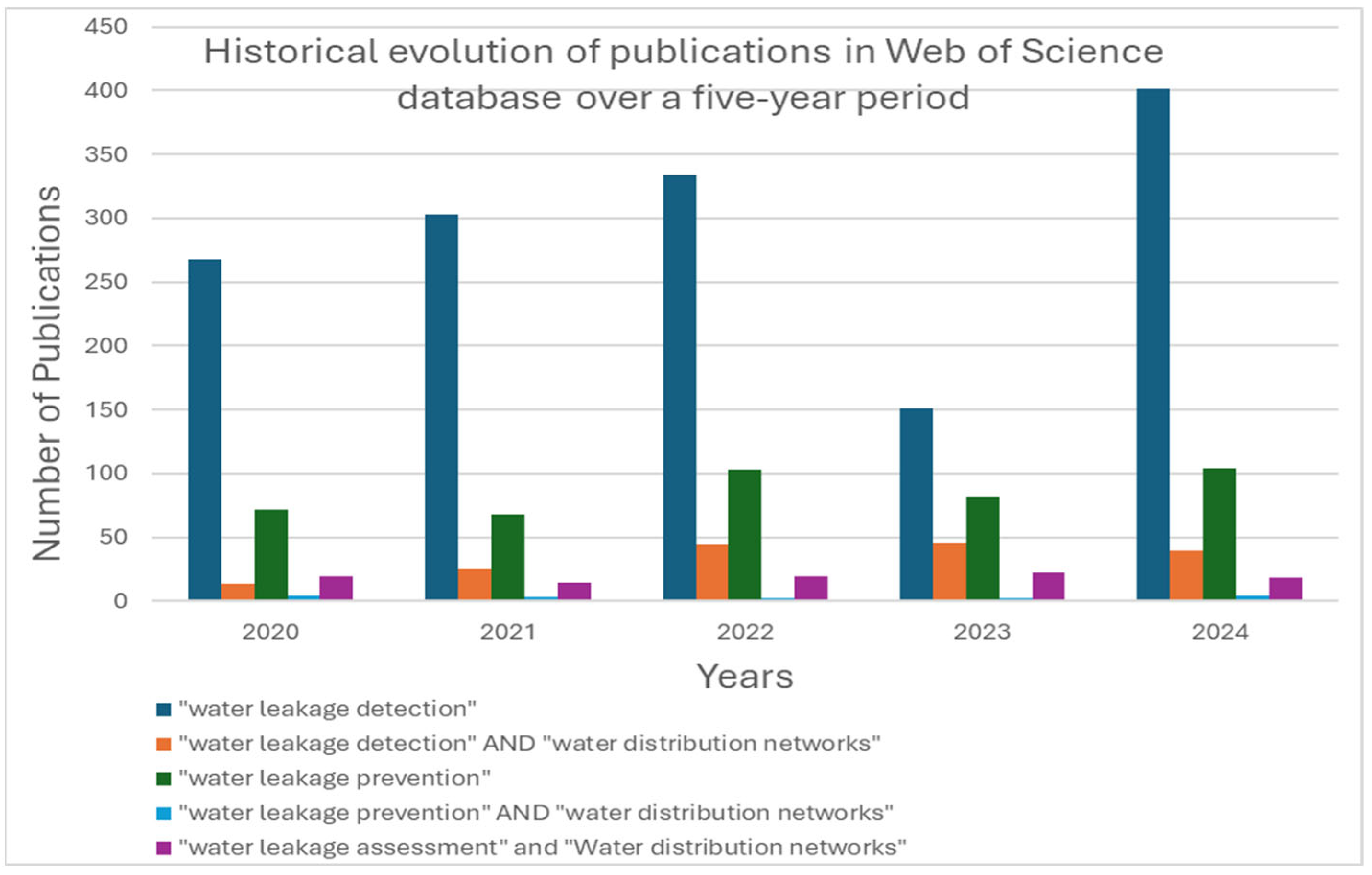

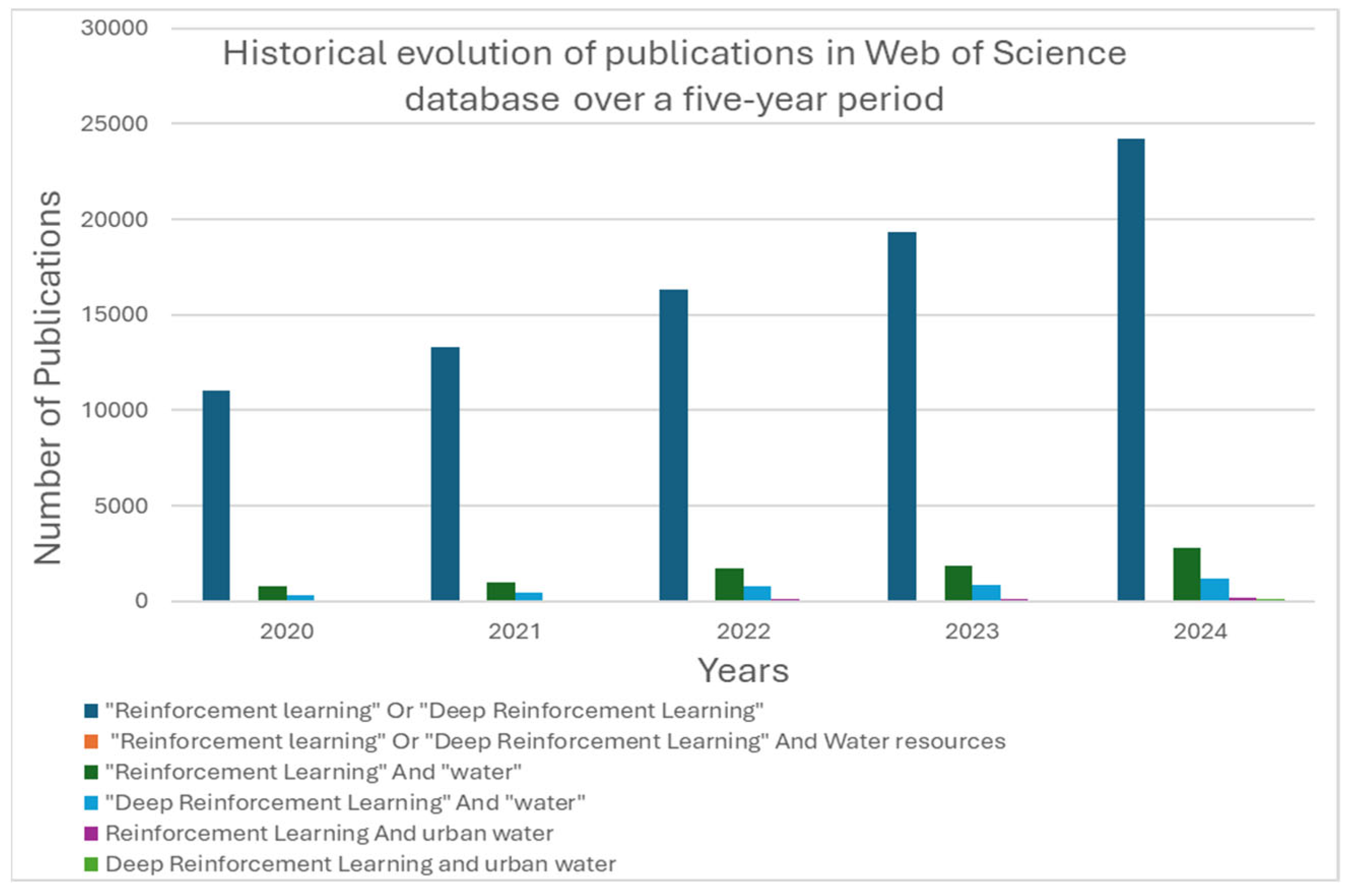
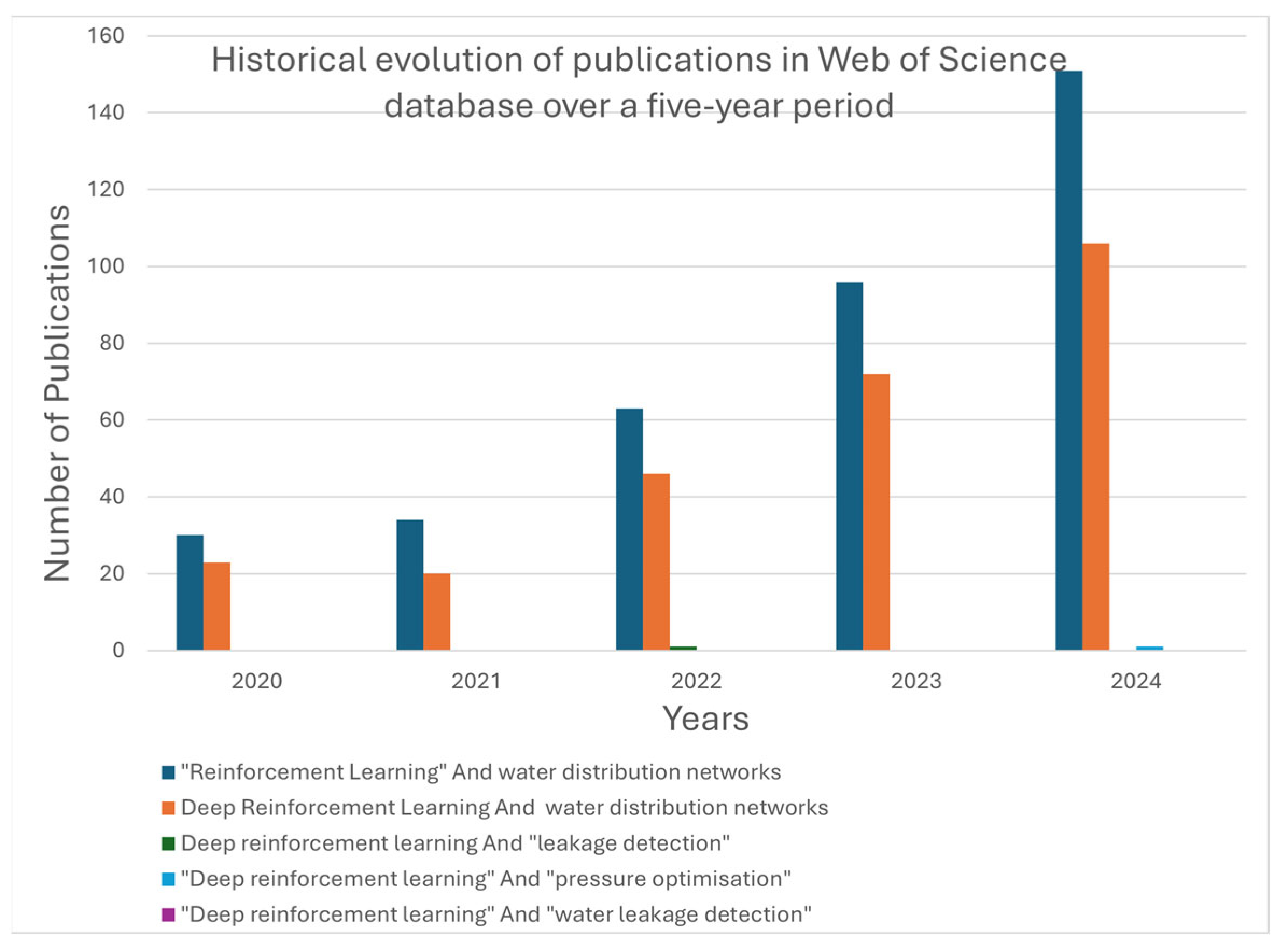
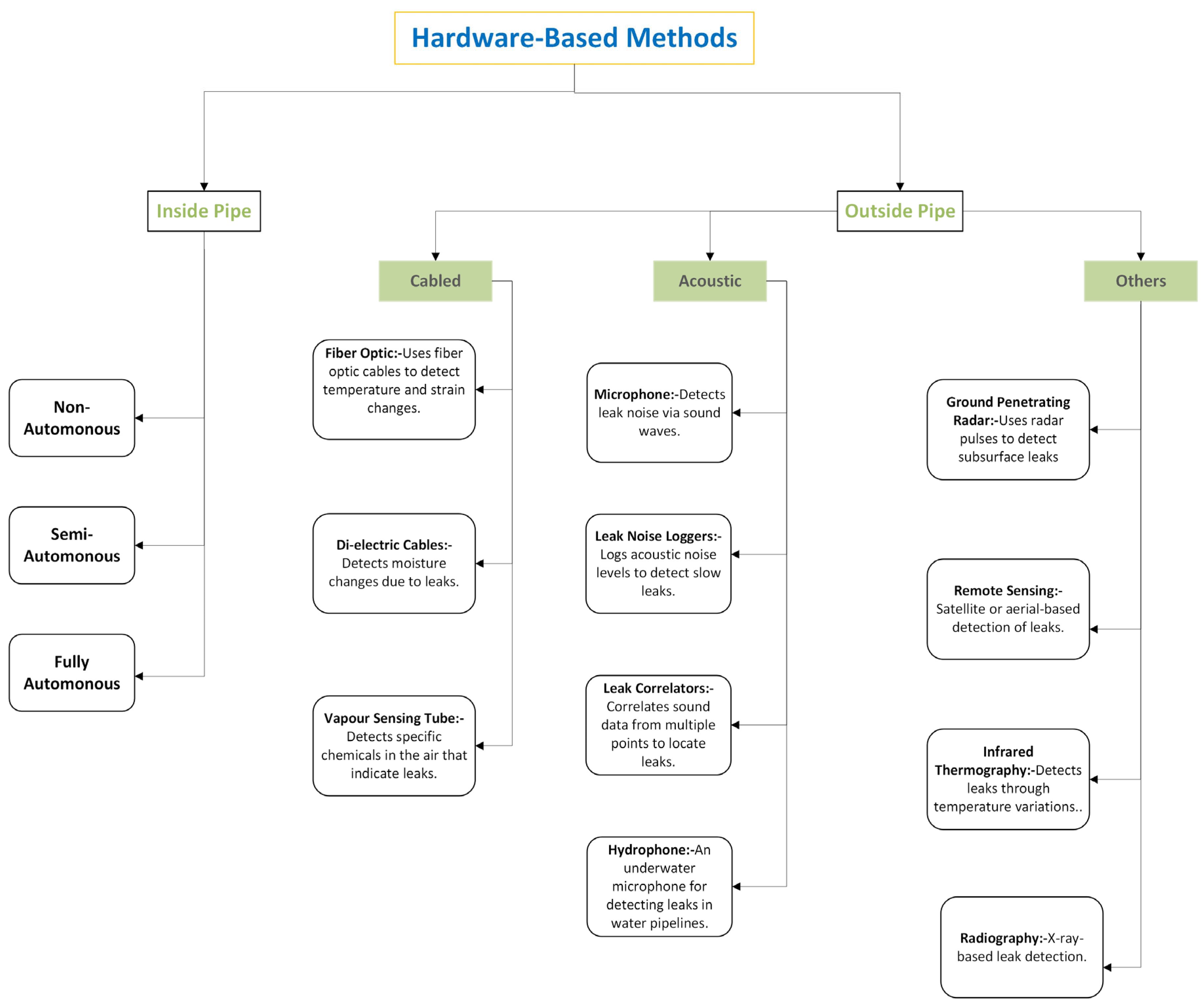
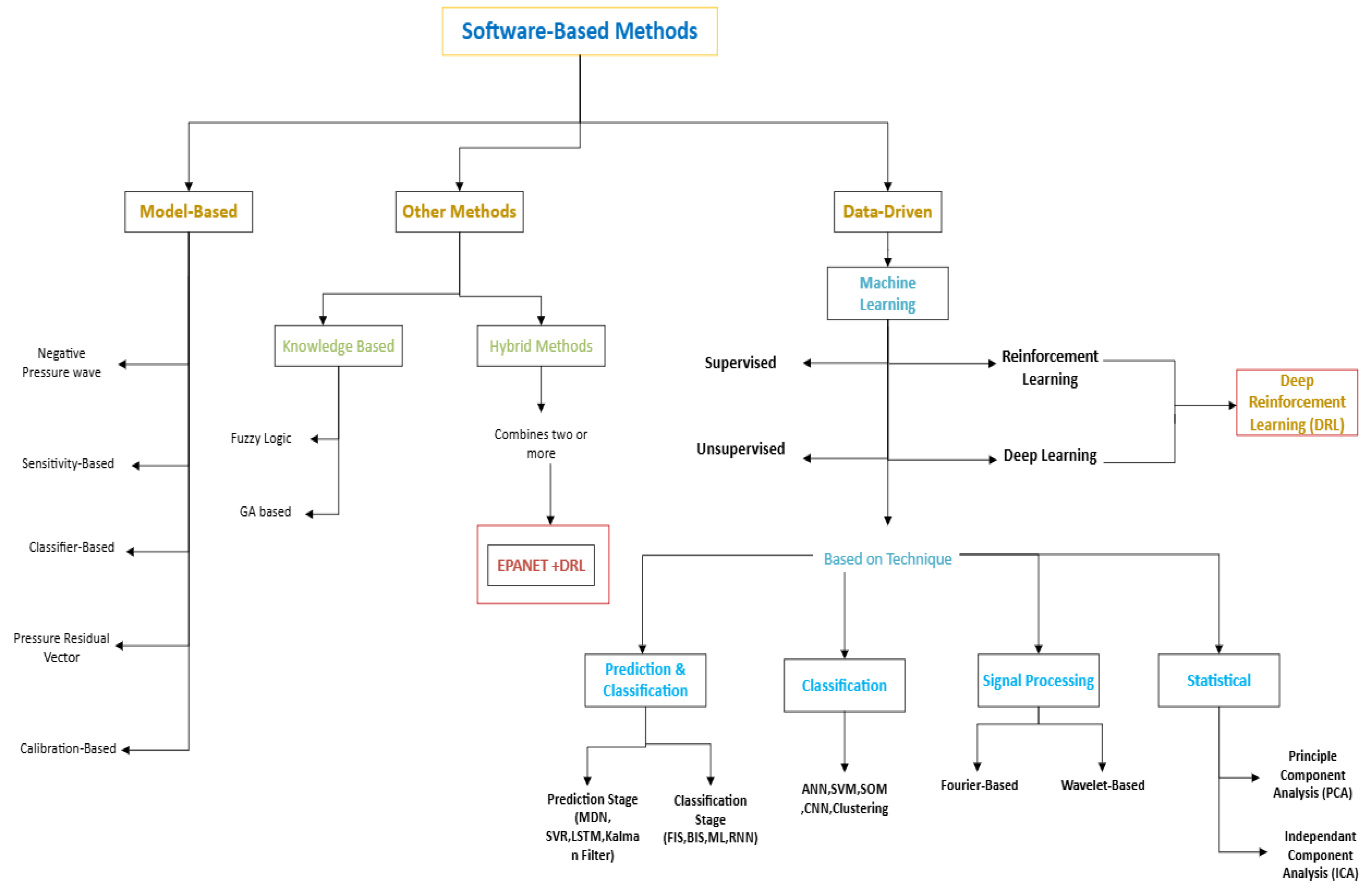

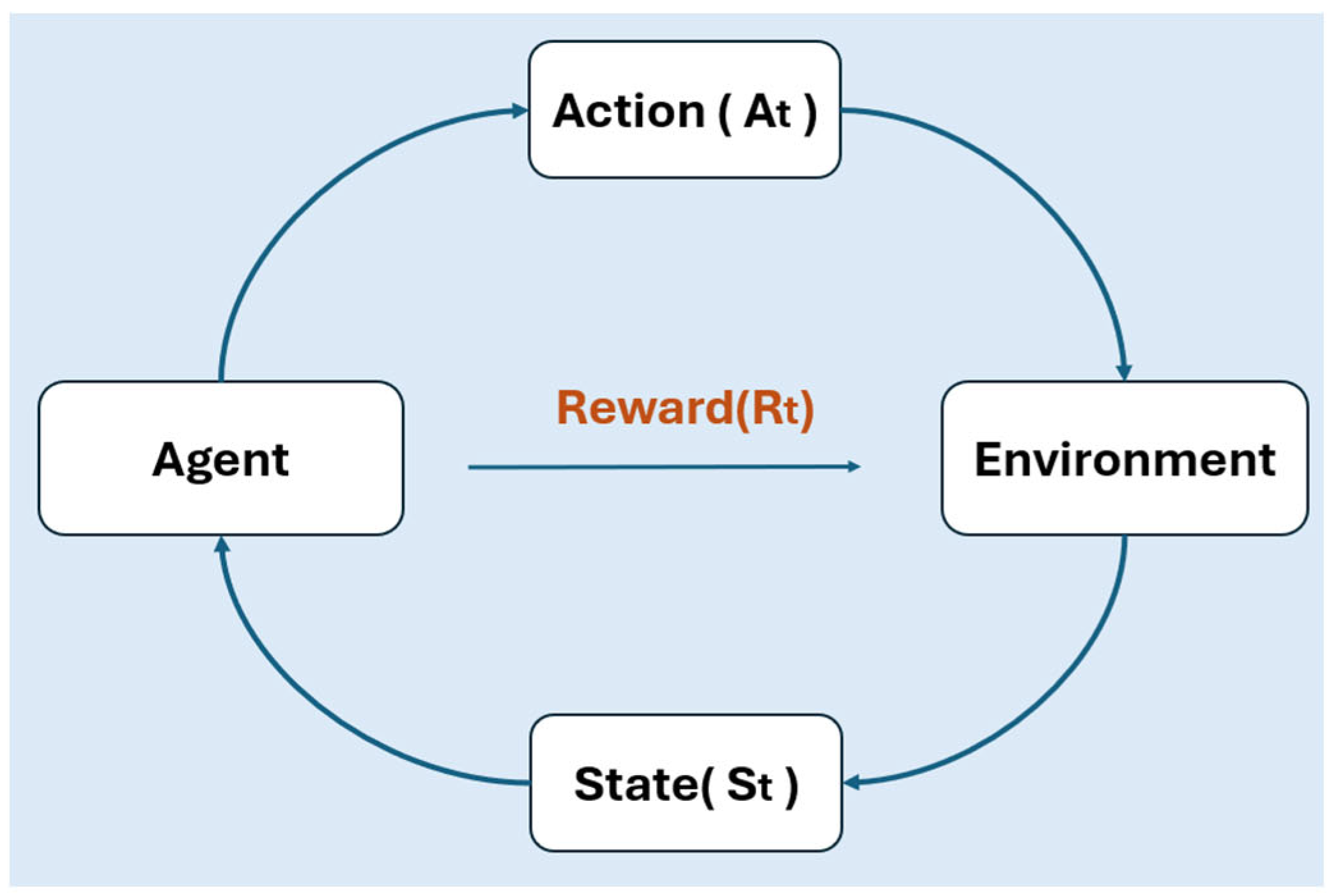
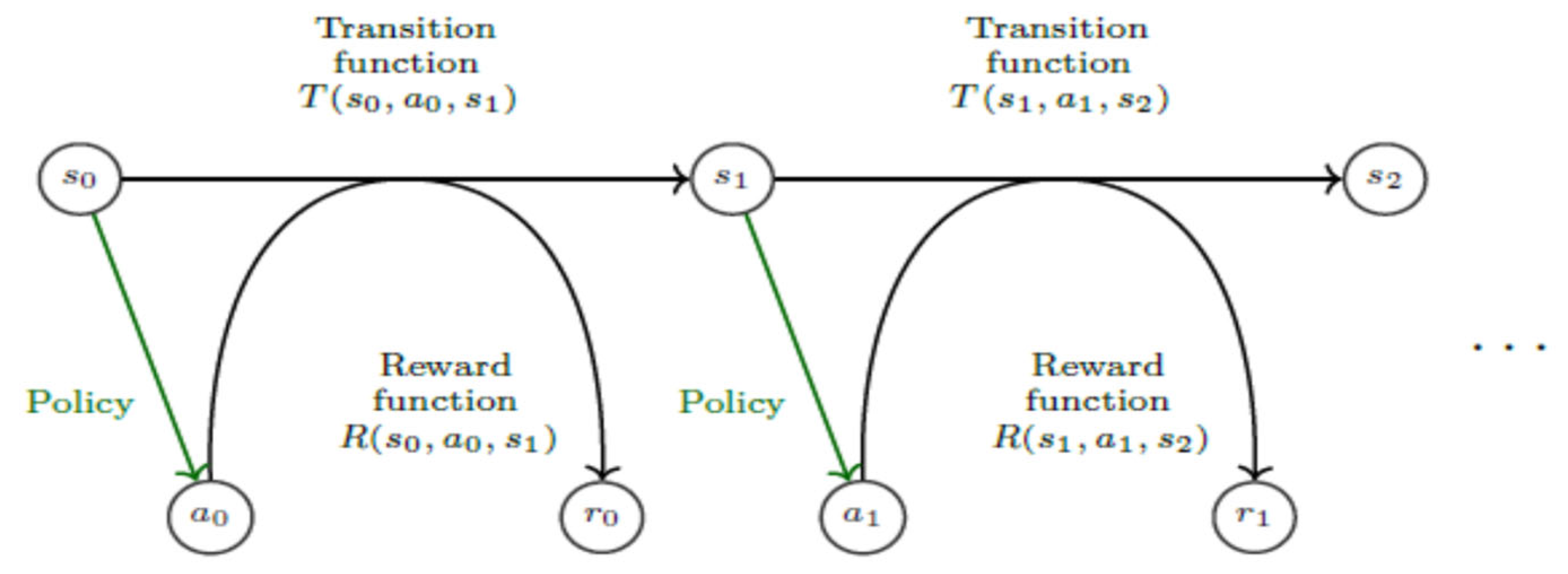



| Method | Principle | Applications | Benefits | Drawbacks | Reference |
|---|---|---|---|---|---|
| Acoustic Emission | Detects leaks by listening to specific sounds inside the pipe via instruments like hydrophones, listening sticks, accelerometers, and correlators. Combines microphones or correlators for precise leak location. | Leak detection in pressurised systems. | Real-time detection of leaks. | Not suitable for large leaks. | [10,15] |
| Fibre Optics | Detects changes in temperature, pressure, or strain in pipe walls. | Monitoring pipelines for leakage. | Monitors pressure and temperature simultaneously. Covers kilometres of pipeline in hours. Survives harsh conditions. | Expensive to install. Can only be used in linear pipelines. | [15,44] |
| Negative-Pressure Waves | Detect leaks by measuring sudden pressure drops, using sensors to localise leaks efficiently. | Leak detection in pipelines. | High accuracy and can localise leaks. | Accuracy depends on pipe material, diameter, and network complexity. | [6] |
| Closed Circuit Television (CCTV) | Use of cameras to detect leaks. | Inspection of pipelines. | Direct pipe condition observation. | Time-consuming and highly costly. Low level of reliability. | [15] |
| Ground Penetration Radar (GPR) | Uses radio waves to image the subsurface and detect reflections, identifying soil gaps to locate pipe leaks. | Detects leaks in buried pipes. | Able to detect leaks in most of the pipe via high-resolution images. | Penetration depth varies with soil type. Requires an experienced operator and has high operational costs. | [15,25] |
| Infrared Thermography | Uses infrared cameras to detect leaks by capturing images of cooler surfaces and identifying temperature differences. | Used to detect leaks under various surface conditions. | Less costly and can be utilised in real-time applications. Non-contact, non-destructive technique. | Requires operator experience. Detection depends on soil type and accuracy is affected by weather conditions. | [10,25,44] |
| RFID (Radio Frequency Identification) | Detects environmental changes and transfers signals to an RFID reader; requires installation. | Monitoring pipelines in areas which are hard to access. | Low power usage and wireless communication. | Limitations because of the range of RFID. | [9,15] |
| Leakage Pinpointing Methods | Combines microphones or correlators for precise leak detection. Main approaches include leak noise correlators (LNCs), the Tracer Gas Technique (TGT), and Pig-Mounted Acoustic (PMA). | Provides precise location of leaks. | High precision; can detect leaks in pipes of various sizes. | Costly and dependent on the leak location in the pipe. Water quality issues can occur during indoor pipe access. | [15] |
| Method | Principle | Benefits | Drawbacks | Reference |
|---|---|---|---|---|
| Statistical Methods | Monitor sensor readings to ensure normal operations, as deviations from standard patterns may indicate the presence of leaks. | Intelligent algorithms are used. Capable of multi-leakage detection. | A large database is needed for better performance. Not suitable for pipelines lacking database entries. | [45] |
| Sensitivity Matrix-Based | Based on pressure measurement and sensitivity analysis of WDNs. | Easy to perform leak---age detection under ideal conditions. | Uncertainties in nodal demands and noise measurement. | [47] |
| Volume Balancing | Looks for difference between input and output to detect leakage. | Simple and based on the principle of conservation of mass. | Less effective in complex systems where demand is variable. | [45,48] |
| Negative Pressure Wave (NPW) | Performing the analysis of pressure wave signals generated to detect leaks. | Low equipment investment and maintenance cost. | Poor detection accuracy and requires strategic sensor placement. | [10,45,48] |
| Real-Time Transient Method | Employing simulations that model the dynamic behaviour of water distribution networks to identify leaks. | Real-time leak detection and localisation. | The simulations are not easy to calibrate because of their complexity and require high computational power. | [10,27,45] |
| Pressure Point Analysis | Identify pipeline leaks by observing pressure reductions that fall beneath a specified threshold throughout the system. | Easy to use and quick to install. | Cannot detect small leaks. | [45,56] |
| Fuzzy Methods | Using fuzzy logic fundamentals to interpret uncertain data. | High accuracy and outputs are easy to interpret. | High computational complexity. | [15] |
| Computational Fluid Dynamics | Utilises numerical analysis and data structures to model free-stream flow. | Effective in high dimensional spaces and does not require explicit statistical models. | Hard to predict the leaks in pipelines. | [15] |
| Water Balance Method | The water balance method calculates water losses by comparing the total input volume with accounted-for consumption and uses. | Effective in quantifying total water loss. | Hard to pinpoint leaks. | [6] |
| Support Vector Machine (SVM) | Utilises classification and regression methodologies to classify data into leak and non-leak categories. | Can process noisy data with significant unpredictability. | Could be less effective for overlapping data points. | [15,46,48] |
| Kalman Filtering | Employs a series of observations to estimate the system’s condition and identify leaks based on the collected data. | Simple to understand and implement. | Assumes that the system might exhibit linear behaviour, which may not always be the case. | [46,48] |
| K-Nearest Neighbours (KNN) | Detects leakages through comparison of present-day information with historical leak trends. | Can model complex nonlinear relationships with flexibility. | May struggle when handling high-dimensional data and is particularly sensitive to noise within the data. | [15,46] |
| Artificial Neural Networks (ANNs) | Mimic the human brain to process the prediction and detection of leaks. Based on input data. | Accurately detect patterns and anomalies in image data. | Require careful design as performance is dependent on many variables. | [15,48] |
| Conventional Neural Networks (CNNs) | Detect leaks from spatial data, such as images from sensors. | Easy to perform leak---age detection under ideal conditions. | Need significant computational resources with large datasets for training. | [15,48] |
Disclaimer/Publisher’s Note: The statements, opinions and data contained in all publications are solely those of the individual author(s) and contributor(s) and not of MDPI and/or the editor(s). MDPI and/or the editor(s) disclaim responsibility for any injury to people or property resulting from any ideas, methods, instructions or products referred to in the content. |
© 2025 by the authors. Licensee MDPI, Basel, Switzerland. This article is an open access article distributed under the terms and conditions of the Creative Commons Attribution (CC BY) license (https://creativecommons.org/licenses/by/4.0/).
Share and Cite
Javed, A.; Wu, W.; Sun, Q.; Dai, Z. Leak Management in Water Distribution Networks Through Deep Reinforcement Learning: A Review. Water 2025, 17, 1928. https://doi.org/10.3390/w17131928
Javed A, Wu W, Sun Q, Dai Z. Leak Management in Water Distribution Networks Through Deep Reinforcement Learning: A Review. Water. 2025; 17(13):1928. https://doi.org/10.3390/w17131928
Chicago/Turabian StyleJaved, Awais, Wenyan Wu, Quanbin Sun, and Ziye Dai. 2025. "Leak Management in Water Distribution Networks Through Deep Reinforcement Learning: A Review" Water 17, no. 13: 1928. https://doi.org/10.3390/w17131928
APA StyleJaved, A., Wu, W., Sun, Q., & Dai, Z. (2025). Leak Management in Water Distribution Networks Through Deep Reinforcement Learning: A Review. Water, 17(13), 1928. https://doi.org/10.3390/w17131928







